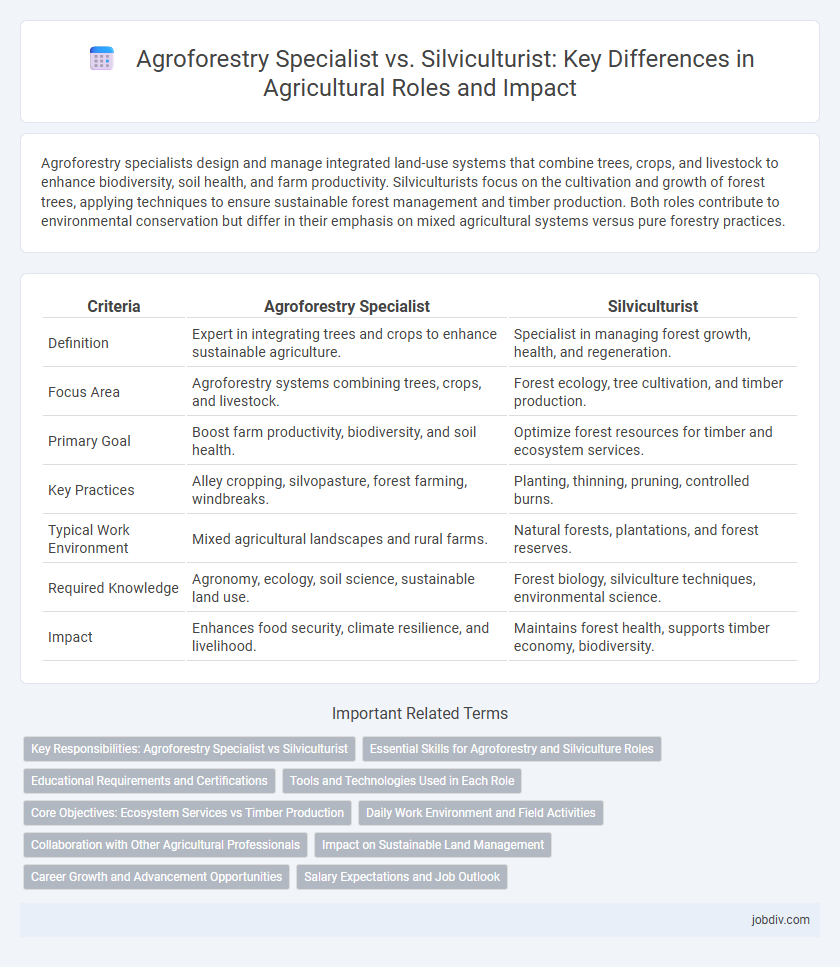Agroforestry specialists design and manage integrated land-use systems that combine trees, crops, and livestock to enhance biodiversity, soil health, and farm productivity. Silviculturists focus on the cultivation and growth of forest trees, applying techniques to ensure sustainable forest management and timber production. Both roles contribute to environmental conservation but differ in their emphasis on mixed agricultural systems versus pure forestry practices.
Table of Comparison
| Criteria | Agroforestry Specialist | Silviculturist |
|---|---|---|
| Definition | Expert in integrating trees and crops to enhance sustainable agriculture. | Specialist in managing forest growth, health, and regeneration. |
| Focus Area | Agroforestry systems combining trees, crops, and livestock. | Forest ecology, tree cultivation, and timber production. |
| Primary Goal | Boost farm productivity, biodiversity, and soil health. | Optimize forest resources for timber and ecosystem services. |
| Key Practices | Alley cropping, silvopasture, forest farming, windbreaks. | Planting, thinning, pruning, controlled burns. |
| Typical Work Environment | Mixed agricultural landscapes and rural farms. | Natural forests, plantations, and forest reserves. |
| Required Knowledge | Agronomy, ecology, soil science, sustainable land use. | Forest biology, silviculture techniques, environmental science. |
| Impact | Enhances food security, climate resilience, and livelihood. | Maintains forest health, supports timber economy, biodiversity. |
Key Responsibilities: Agroforestry Specialist vs Silviculturist
Agroforestry specialists focus on integrating trees and shrubs into agricultural landscapes to enhance biodiversity, improve soil health, and increase crop productivity. Silviculturists specialize in the growth, cultivation, and management of forest trees, emphasizing sustainable timber production and forest ecosystem health. Both roles require expertise in plant biology and ecosystem management but differ in their primary goals and land-use practices.
Essential Skills for Agroforestry and Silviculture Roles
Agroforestry specialists require expertise in integrating trees and shrubs into agricultural landscapes to enhance biodiversity, soil health, and crop productivity, with skills in ecological assessment, species selection, and sustainable land management. Silviculturists focus on the science of forest cultivation, emphasizing tree growth, forest regeneration, and timber yield optimization through knowledge of silvicultural systems, pest management, and forest monitoring. Both roles demand strong analytical capabilities, understanding of ecosystem dynamics, and proficiency in land use planning to support sustainable environmental and economic outcomes.
Educational Requirements and Certifications
Agroforestry specialists typically require a bachelor's degree in agriculture, environmental science, or forestry, with additional certifications in agroforestry practices or sustainable land management enhancing their credentials. Silviculturists generally hold a degree in forestry or natural resource management, often complemented by certifications such as Certified Silviculturist or Forestry Professional licenses that validate expertise in forest cultivation and management. Both roles benefit from ongoing professional development and specialized training to stay current with advances in sustainable practices and ecosystem management.
Tools and Technologies Used in Each Role
Agroforestry specialists utilize geographic information systems (GIS), remote sensing technology, and soil health monitoring tools to integrate trees with crops and livestock for sustainable land use. Silviculturists rely heavily on dendrometers, tree corers, and computer modeling software to manage forest regeneration, growth, and health effectively. Both roles employ drone technology and data analytics to assess vegetation conditions but apply these tools to distinct ecological and productive objectives in agroforestry versus forest management.
Core Objectives: Ecosystem Services vs Timber Production
Agroforestry specialists prioritize ecosystem services by integrating trees with crops and livestock to enhance biodiversity, soil health, and water management, promoting sustainable land use. Silviculturists concentrate on timber production, applying silvicultural techniques to optimize tree growth, forest regeneration, and wood quality for commercial purposes. Both roles contribute to forest management but differ in their core objectives--agroforestry focusing on multifunctional landscapes and silviculture on maximizing timber yield.
Daily Work Environment and Field Activities
Agroforestry specialists design integrated land-use systems combining trees and crops, spending much of their daily work assessing soil health, managing tree-crop interactions, and advising farmers on sustainable practices. Silviculturists primarily focus on forest management, conducting field surveys to evaluate tree growth, implementing thinning and planting operations, and monitoring forest health to promote optimal timber production. Both roles require extensive outdoor fieldwork, but agroforestry specialists engage more with agricultural landscapes while silviculturists concentrate on natural forest ecosystems.
Collaboration with Other Agricultural Professionals
Agroforestry specialists collaborate closely with agronomists, soil scientists, and sustainable farming experts to integrate trees, crops, and livestock systems for enhanced biodiversity and soil health. Silviculturists work alongside forest ecologists, wildlife biologists, and land managers to develop and apply sustainable forest management practices focusing on tree growth, quality, and regeneration. Both professionals prioritize interdisciplinary cooperation to optimize land use, increase productivity, and promote environmental sustainability in agricultural landscapes.
Impact on Sustainable Land Management
Agroforestry specialists integrate tree cultivation with crop and livestock farming to enhance biodiversity, improve soil health, and promote water conservation, directly supporting sustainable land management. Silviculturists focus on managing forest regeneration, composition, and growth to sustain timber production and ecosystem services, ensuring long-term forest resource sustainability. Both roles contribute to sustainable land use but differ in scope: agroforestry specialists prioritize multifunctional landscapes, while silviculturists concentrate on forest ecosystem management.
Career Growth and Advancement Opportunities
Agroforestry specialists benefit from expanding demand for sustainable land management, with career growth in environmental consulting, research, and policy development. Silviculturists find advancement opportunities primarily within forestry management, timber production, and conservation agencies, emphasizing skills in forest regeneration and management. Both careers offer potential for leadership roles, but agroforestry specialists often engage more broadly with agricultural systems and climate resilience initiatives.
Salary Expectations and Job Outlook
Agroforestry specialists typically earn between $50,000 and $75,000 annually, benefiting from roles in sustainable land management and integrated farming systems, with job growth driven by increasing environmental awareness and demand for climate-resilient agriculture. Silviculturists often have salaries ranging from $60,000 to $85,000, with strong opportunities tied to forestry management, timber production, and conservation projects, supported by the ongoing emphasis on sustainable forest management. Both careers show positive job outlooks, but silviculturists may experience more steady demand due to their focus on large-scale forestry operations and regulatory compliance.
Agroforestry Specialist vs Silviculturist Infographic

 jobdiv.com
jobdiv.com